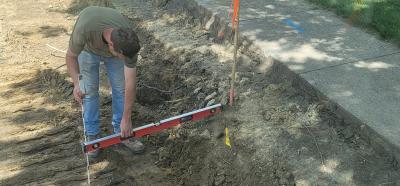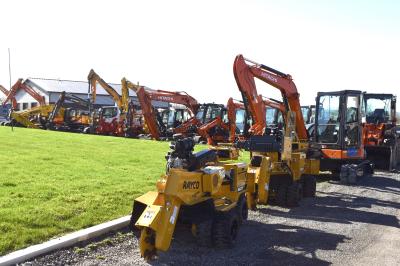As a cold, hard winter sets in on Minnesota, road crews have reached the half way point in construction of a diamond interchange to replace the last two, signalized intersections on a 90 mi. (144 km) stretch of a busy highway running between the Twin Cities of St. Paul and Minneapolis and I-90. Located on TH 52 in the rural city of Cannon Falls, nearly midway between the Twin Cities and I 90, the signalized intersections sit very close to each other and are the primary connections to the city from the four lane highway.
Another six, non-signalized, lesser used crossings that serve the area also will be eliminated when the interchange is completed.
Known for its bucolic qualities, Cannon Falls is a popular restaurant stop for travelers and truckers, an agricultural center with a growing industry and future home to a new Mayo Clinic satellite hospital.
As the four lane highway approaches Cannon Falls, it carries an ADT of more than 20,000 along the west side of this rural town of 4,000 residents. The two current, at grade signalized county road crossings of the highway carry a combined ADT of more than 18,000.
Improved safety and efficiency for the motoring public are the primary reasons for this project, according to the Minnesota Department of Transportation, (MnDOT). At the same time, this project will meet the projected residential, commercial and industrial growth for the area according to reports posted on the MnDOT Web site for this project.
Equally important, the city of Rochester sitting just 10 mi. (16 km) north of I-90 and home of the world renowned Mayo Clinic, will finally be connected to the sprawling Twin Cities metropolitan area and its system of freeways by a minimum access controlled highway.
The city of Rochester, with a population of 107,000 residents, is not only a medical mecca, it is a busy agricultural and industrial center with its own airport. It is the only Level I trade center in the state that has not been connected by a freeway to the Twin Cities, the MnDOT reports further noted.
S.M. Hentges & Sons Incorporated, based in Jordan, Minn., took on the project with a low bid of $14.3 million. Established in 1981 by Steve and Jeanette Hentges with two pieces of equipment, the company has now grown to running more than a dozen crews and dozens of pieces of heavy equipment. It specializes in highway and heavy excavation and construction, utility construction, concrete work, bridge construction, piling, erosion control, site development and trucking operations.
Both MnDOT and the contractor are pleased with the construction and progress crews have made over the last six months.
“Construction went well the first season thanks to the concerted effort by our contractor and the weather. Most of the rough grading, drainage, and bridge construction has been completed,” said Paul Schauer, MnDOT project manager. “Issues caused by delayed right of way acquisition and utility relocations have been mitigated and we are on schedule for an October, 2014 completion.”
Added Steve Engstrom, S.M. Hentges project superintendent, “we appreciate the efforts and cooperation of all the stakeholders of this project. A tremendous amount of time has been invested to get the project to this point. I’m confident our crews will build an interchange that will benefit the citizens for years to come.”
This project is one of many improvements by the Minnesota Department of Transportation ( MnDOT) to make TH 52 a minimum access controlled freeway between I-90 and the I-694/494 loop around the Twin Cities.
Last year, MnDOT completed similar improvements just south of the current work with the construction of a diverging diamond interchange at Pine Island, Minn. And several years ago, an 11 mi. (18 km) section of this highway was widened through Rochester.
Along with a safer and more efficient connection to Cannon Falls, the new interchange will eliminate the confusion drivers suddenly face when they meet two signalized intersections a short distance apart on a highway that otherwise appears to be a freeway.
“Drivers on TH 52 experience the corridor as a combination freeway facility or a rural expressway and do not expect to encounter traffic signals. Therefore, many drivers are not prepared to slow down or stop at these locations, which can lead to high-speed, severe crashes” according to a report published by MnDOT.
The report further noted that the two current, at grade signalized intersections at Cannon Falls have a higher crash rate than normal that result in serious injuries and fatalities.
In addition to the interchange, the current county and local road system will be extended. With much of it dug out from virgin ground, approximately 24,000 ft. (7,320 m) of asphalt frontage and county roads stretching east, west and south of the new interchange will be placed to make these geometric improvements.
Because of the loss of eight at-grade crossings, the extension of the county road system on both sides of the highway was a necessity.
“There is a lot of frontage road work resulting from the closure of at-grade median entrances and the two signalized intersections,” Engstrom said. “We’re putting in the frontage road system to connect everything back to the interchange.”
A lot of work that featured blasting and pipe jacking operations has been accomplished since construction started in July.
“We have the bridge up and the deck is poured, the west frontage road is roughed in and on the east frontage road, all the rock excavation is done along with the grading. We also have quite a few box culverts in and storm sewer pipe,” Engstrom said.
With all the excavating and grading work required, S. M. Hentges and its subcontractors had a good representation of more than two dozen pieces of equipment on hand for the digging and earth moving operations. Included in this mix were Komatsu and Cat excavators, Cat dozers and loaders, John Deere scrapers, Cat and Volvo articulated dump trucks, Dynapac compactors and John Deere tractors pulling rollers and water tankers for dust control.
Gomaco equipment moved in for the concrete paving and curb work while S.M. Hentges brought in an American 7250 crane and Truck Crane Service Company in Eagan, Minn., rolled in a Grove GMK 6350 and Demag AC395-1 hydraulic all terrain cranes for the bridge construction.
Excavation along a section of the new alignment for the east frontage road was not just a simple dig and dump operation. Preliminary testing showed rock sat below approximately 2,000 ft. (610 m) of the new road alignment.
Kasbohm Custom Drilling Inc./KBC Inc. a company based in Savanna, Ill., with more than 41 years of experience arrived on site to loosen the solid rock.
Over a period of one month, dynamite crews blasted and loosened solid rock below the new road alignment. Excavating crews followed behind with a pair of Komatsu and Volvo excavators to scoop up and dump the shattered material into a string of Cat dump trucks to haul all 100,000 cu. yd. (76,500 cu m) back to the bridge approaches to be used for the common embankment
Though the blasting went well, poor soil conditions below sections of the new road alignment did hamper parts of the blasting operations.
“The rock wasn’t very consistent and made shooting kind of difficult,” said Terry Hartung, a supervisor with KBC Inc. “We had a lot of large floaters in there; a lot of clay and water. For the most part though, it shot pretty well.”
Crews blasted an average of a 150 by 40 ft. (46 by 12 m) section at a time with some of the rock reaching up to 30 ft. (9 m) in depth.
Blasting crews from Minnesota used Ingersoll-Rand ECM 490, 590 and 670 hydraulic drills to drill the rock to set 2,575 charges. Each of the 30 shots were monitored by a Nomis 5400 seismograph.
With the addition of thousands of feet of additional road surface, box culverts, ponds and jacked pipe are all part of the storm water run-off design. Part of this included draining run-off from the northeast quadrant of the interchange through a culvert jacked under the pavement to the west side of the highway.
S.M. Hentges brought in EJM Pipe Services Inc., a 40 year old company based in Lino Lakes, Minn., for the jacking operations.
Using Akkerman tunneling equipment, EJM crews pushed approximately 170 ft. (52 m) of 48 in (122 cm) RC pipe below four lanes of the highway. Run-off will flow to a holding pond on the west side of the highway and drain into twin barrel 60 in (152 cm) pipes that lead to a natural underground drainage pattern.
Though “it was a little more difficult than normal, shallow and close to solid rock, it went across fairly well and took the better part of three weeks,” said Mark Montgomery, project manager of EJM Pipe Services.
All of the construction has taken place over daylight hours except for the bridge construction over the highway. Bridge crews stepped outside the day time schedule and worked night time hours to take advantage of lower traffic volumes to set the beams for the super structure.
Lead by S.M Hentges, a team with E & J Rebar, Anoka, Minn., and Lefebvre Trucking, Elk River, Minn., set the beams.
With the help of the state patrol, officers closed down traffic for short periods of time to allow crews to safely jockey the beams into position. When completed, the bridge crossing over the road pavement below will be 230 ft. (70 m) long, 57 ft. (17 m) wide with a 12 ft. (4 m) sidewalk.
Road crews completed the bridge deck last fall and operated a Gomaco C-450 Cylinder finisher to get the job done. Curb and gutter for the bridge will be poured this season with a Gomaco Commander II.
Local residents and area farmers also will see a change in traffic control at the ramps of the interchange and new county road system. Four round-a-bouts will take the place of the more traditional left turn movements. One pair will be located at the ends of the interchange ramps to route drivers in and around the interchange and the second pair will be located farther east and west of the interchange and control traffic coming out of or into the new frontage road network.
Construction has now shut down for the winter. When warmer weather returns this spring “there is some drainage that needs to be pulled away from the embankment and we’ll need to pour the approach panels for the bridge and pour a 2 in. (5 cm) low slump concrete for the wear course,” Ryan Kniefel, S.M. Hentges project manager said. Then, “the bridge rail will be installed and the center median and sidewalk will be poured.
On the roadways, aggregate base, curb, gutter, sidewalks and paving will be completed this year along with the signing, signals and lighting installations. On the highway itself, the existing at-grade intersections and traffic signals will come out and an overlay of the existing pavement through the limits of the construction also will be done.
The contractor and MnDOT are shooting for an Oct. 3 completion date this year.
Today's top stories















